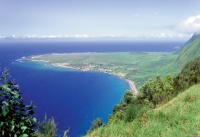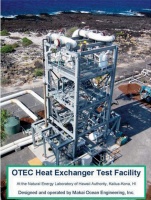
Thanks to the development of systems that can harvest energy from its waves, tides and currents, the ocean is viewed as in increasingly valuable source of power. But according to the proponents of technology that exploits the sea’s ability to trap solar energy, we haven’t seen anything yet.
The technology, Ocean Thermal Energy Conversion (OTEC), could, they say, transform the way we use energy, allowing us to supply huge quantities of non-polluting, baseload power. It could also help desalinate water and provide refrigeration to local communities.
According to some estimates, more than 300 times the energy we currently consume is available from the solar energy that is constantly stored in the upper layers of the tropical ocean. On an average day, 60 million square kilometres of tropical seas absorb an amount of solar radiation equivalent in heat content to around 250 billion barrels of oil. Tapping into that potential has been the goal of OTEC scientists for more than a century.
Invented in 1881 by a visionary French scientist, Jacques-Arsène d’Arsonval, OTEC uses the temperature difference between the warmer water of oceans and the colder water that can be found up to 1km below the sea’s surface. In some tropical regions, this difference is enough to operate vapour turbines that drive generators and produce electricity and fresh water as a byproduct.
In the 19th century, d’Arsonval couldn’t prove the viability of OTEC. But its potential captured the imagination of a small group of researchers. The oil crisis of the 1970s brought the radical technology into the mainstream, and work in Europe, the US and Japan began to gain momentum. No sooner had it started, however, that petroleum prices dropped and investors lost interest.

The future for OTEC, however, could be in open grazing plants. If the technology can be proven on a full-scale floating plant, engineers will develop a system that is free to drift across the ocean. The plant would use the power generated from thermal differences to split seawater into liquid hydrogen and liquid oxygen. The hydrogen could be offloaded into tankers and taken to countries that need liquid hydrogen as part of their infrastructure.
’This could happen within the next 10 years,’ said Varley. ’While the UK’s waters aren’t warm enough for direct use, a grazing plant could help to import much-needed alternative fuels for transport.’ If this happens, it would require huge investment at the cost of other renewable technologies. But Varley believes the return will be worth it. ’The real advantage is in autonomy,’ he said. ’Do you want to import oil from our friends - or not-so friends - in other countries, or from developments that Great Britain controls? That’s the question that needs to be asked.’
Timeline
Good for the solar
From a radical concept to a serious idea awaiting congress approval
- 1881 French scientist Jacques-Arsène d’Arsonval reveals his idea to tap into the thermal energy of the ocean.
- 1926 Georges Claude, one of d’Arsonval’s students, begins research into OTEC for commercial use.
- 1935 Claude attempts to build an open-cycle plant aboard a 10,000-tonne cargo vessel, but fails.
- 1956 French researchers design a 3MW open-cycle plant for Abidjan on Africa’s west coast. The plant was never completed owing to high costs.
- 1974 The Natural Energy Laboratory of Hawaii is established as a test facility for OTEC technologies.
- 1981 Japan demonstrates a shorebased, closed-cycle plant in the Republic of Nauru in the Pacific Ocean.
- 2009 The US Navy awards Lockheed Martin $8m to develop a 5MW OTEC pilot plant.




JLR teams with Allye Energy on portable battery storage
This illustrates the lengths required to operate electric vehicles in some circumstances. It is just as well few electric Range Rovers will go off...